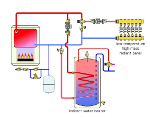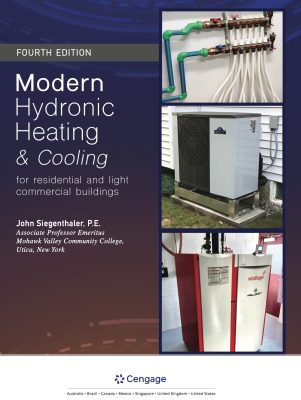Cold Showers And Rusty Vents
The hydronic system shown was intended to provide heat to a radiant floor slab and an indirect water heater.
The Glitch
The hydronic system shown below was intended to provide heat to a radiant floor slab and an indirect water heater. Either load can independently call for heat as needed based on thermostat settings. The owner sets the space heating thermostat back 5 degrees F at bedtime, and then resets it to normal comfort temperature when he rises at 6 a.m.
His complaint is that the water temperature gets progressively cooler during his morning shower, even though he insists the boiler is firing nonstop during this time. He’s also wondering why there are rust spots forming on the boiler’s galvanized vent pipe, even though it’s only a few months old.
Can you spot some design details that are likely causing these problems?
The Fix
The cause of the cold shower is the combination of a high-mass distribution system recovering from setback and a nonprioritized indirect water heater. It’s very possible that during this time, the distribution system is absorbing heat faster than the boiler can produce heat - even under continuous operation.
Heat stored in the indirect water heater during the previous night might even be leaving the tank under this condition since the tank and distribution system are both operating.
The solution is to make the indirect water heater a priority load. Most modern zone controllers make this as simple as a switch setting. When the indirect water heater is operating, the circulator(s) supplying space heating are temporarily turned off. Thus, all heat output from the boiler is directed to the water heater and the system is cranking out DHW at its maximum possible rate.
The rusty vent pipe is likely caused by sustained flue gas condensation in the boiler. The original system has no means to monitor boiler inlet temperature, and thus it cannot be controlled. When the low-temperature floor-heating system is operating, the boiler water temperature is being depressed well below the dewpoint of the exhaust gases because the system is seeking thermal equilibrium between rate of heat production and rate of heat release.
The water temperature drops until this balance is achieved. Thermodynamics could care less whether the boiler is operating in condensing or noncondensing mode.
The solution, assuming the installer wants to work with thermostatic mixing valves, is to install another such valve and circulator as shown in the fix drawing. The second valve provides a second mixing point to boost boiler inlet temperature above 130 degrees F. The second circulator is essential in allowing this mixing operation. The distribution system is interfaced to the temperature-protected boiler loop using closely spaced tees to provide hydraulic separation.
True, it’s a bit more expensive, but it sure is better than venting carbon monoxide into someone’s house through a failed vent connector.
Other glitches in the original drawing include:
1. Lack of a central air separator.
2. Incorrectly oriented purging valves. The drain port must be upstream of the inline ball valve.
Links
Looking for a reprint of this article?
From high-res PDFs to custom plaques, order your copy today!








